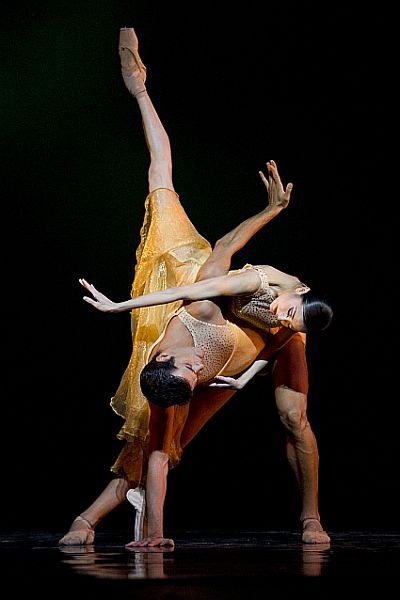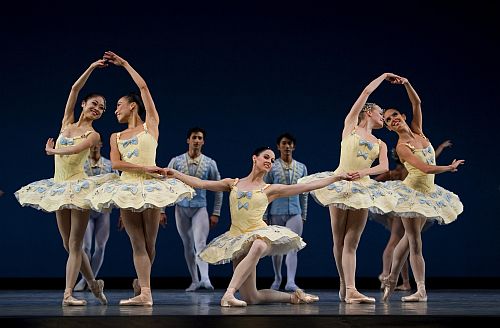 United Kingdom San Francisco Ballet (Programme A): Dancers and Orchestra of the San Francisco Ballet / Martin West (conductor), Sadler’s Wells, London, 14.9.2012. (JPr)
United Kingdom San Francisco Ballet (Programme A): Dancers and Orchestra of the San Francisco Ballet / Martin West (conductor), Sadler’s Wells, London, 14.9.2012. (JPr)
Balanchine: DivertimentoNo.15
Liang: Symphonic Dances
Wheeldon: Number Nine
San Francisco Ballet was last here in 2004 garnering great reviews and subsequently an Olivier Award for outstanding achievement in dance. They return for a 10 day residency with three programmes of mixed bills showcasing their pre-eminence in contemporary ballet. Much is made of the diversity of the dancers in both background and physique that their artistic director since 1985, Helgi Tomasson, has melded into an ensemble at ease in a breadth of choreography encompassing the Russian classics, as well as Balanchine and those of a newer generation. Having been founded in 1933 it seems its best years are now or even still ahead of them.

Hinting about the size of the dancers leads me to two outstanding performers in Edwaard Liang’s new work Symphonic Dances, Yuan Yuan Tan and Vito Mazzeo. Tan had the fragility of her Chinese origins grafted onto the taller stature and slender body we are more familiar with in the West. Mazzeo had the most amazingly expressive arms I have seen on any dancer, Nureyev included. I don’t know if he has danced Fokine’s Le Spectre de la Rose but he seems born for it. Their duet was a highlight of this hyperactive work. I believe Sergei Rachmaninov’s always wanted this 1940 orchestral suite – his final composition – to become a ballet. It had to wait till this year for Edwaard Liang to realize this; it features six of the San Francisco Ballets’ soloists and apart from Tan and Mazzeo, gives Tiit Helimets, Sofiane Sylve, Maria Kochetkova and Vitor Luiz a chance to shine. Together with a glittery corps de ballet we saw men in shorts and women in flowing dresses, the principal colours being red-orange or yellow often against a red backdrop. The music is intense, restless and redolent of the composer understanding of his own mortality and Liang’s steps matched this in the athleticism it demanded in leaps, lifts and spins and empathy in the pas de deux that death might not just be an end but could be a beginning.
The evening ended with Christopher Wheeldon’s Number Nine, a 16 minutes trite but entertainingly sporty piece – something of a suitable tribute to the triumphant London summer Olympics. There were more shorts and this time gym skirts for the women and taking the lead were four couples in bright colours predominantly red, blue, lime-green and purple. According to Wheeldon it is ‘just a dance’ and was pleasant enough in the rampant kaleidoscopic gymnastic style of a physical workout. There was also a pleasant touch of humour as the dancers stopped briefly to conduct their own accompaniment of Michael Torke’s richly-textured Ash.

In fact the best part of this first programme was over before the first interval and George Balanchine’s 1956 Divertimento No.15 to Mozart’s gracious music overshadowed all that came after it. This tutu ballet was the perfect dazzling synthesis of the choreographer’s Russian heritage and the contemporary energy of his new American homeland. Together with the corps de ballet everyone was in suitably pretty costumes and it featured five female dancers and three male ‘chevaliers’ in solo moments, duets and trios of harmonious, elegant, classicism: nothing is predictable and it is sublimely brilliant. What I admired most – apart from the company’s evident artistry – was the totally genuine smiles on all the dancers’ faces. They were enjoying themselves and so did we watching them. I am loath to pick anyone out from such an ensemble piece but France Chung caught the eye with her grace and precision here and in Number Nine.
These ballets could probably have been danced to recorded music but thankfully San Francisco Ballet did not go down this road, however their scratch orchestra will need a few performances to become totally at ease I believe. Their attempt at Mozart, Rachmaninov and Torke was a valiant one and I have heard worse ballet orchestras. Certainly the San Francisco Ballet’s experienced music director Martin West did his best to keep them all together and he was, as to be expected, suitably supportive of the dancers in front of him.
I am sure the other two programmes the company will be performing will attract full houses too and please catch one of their performances if you can.
Jim Pritchard
For more information about the San Francisco Ballet and other forthcoming dance events at Sadler’s Wells visit http://www.sadlerswells.com/.